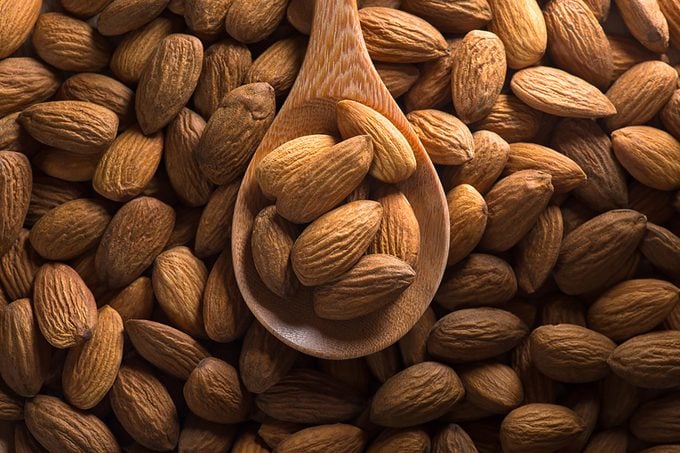Here Are the Almond Nutrition Facts You Need to Know
Updated: Apr. 01, 2021
Almonds are a popular snack full of protein, vitamin E, healthy fats, fiber, and more. Here are the almond nutrition facts you should know.
Almonds: A versatile nut
Almonds are having a moment that may just turn out to be a movement. The tasty tree nut, which hails from the Mediterranean, is a popular healthy snack in its own right. But it’s also showing up in flours, milk, cheeses, snack bars, and more thanks its to its potential health benefits.
“You can buy almonds in various forms—whole, sliced, slivered, or as flour, milk, paste, and even oil,” says Katrina Hartog, RD, clinical nutrition manager at Lenox Hill Hospital in New York City. “Each is unique in its form, but all are delicious and nutritious.”
Americans can’t seem to get their fill of almonds. About 2 billion pounds of almonds are consumed per year in the U.S., and that number has been rising steadily, according to the Agricultural Marketing Resource Center, a group funded by the U.S. Department of Agriculture. More people are embracing vegetarian or vegan lifestyles and/or meatless Mondays, further fueling almonds’ rising popularity.
 Almonds: A brief history
Almonds: A brief history
While the almond’s popularity has been exploding of late, this tree nut can be traced all the way back to 1400 B.C, says Hartog.
Almonds fall to the ground from trees, are picked up by machine, and then sent to handlers where they are processed and sold. Unlike other nuts, almonds are actually more closely related to the peach, plum, apricot, and other fruits that have a stony pit.
California is the only state in the U.S. that produces almonds commercially, turning out 80 percent of the world’s supply, Hartog notes. Almonds can be sweet or bitter, but only sweet almonds are grown in California. Almonds can be further classified by size, shape, and “blanchability.” Raw almonds typically have a layer of red-brown skin around the nut, while blanched almonds have been boiled to remove the skin. Marcona almonds are blanched. (Almonds are among the healthiest nuts you can eat.)
 Almond nutrition facts
Almond nutrition facts
There’s a whole lot of nutrition packed into an almond’s tiny, tough shell. A one-ounce serving (or about 23 almonds) provides:
Calories: 162
Protein: 6 g (12% DV)
Fat: 14 (21% DV)
Carbs: 6 g (2% DV)
Fiber: 3.5 g (14% DV)
Sugar: 1 g (2% DV)
Vitamin E: 7.4 mg (37% DV)
Calcium: 75 mg calcium (7% DV)
Almond health benefits
Heart-healthy fats
Almonds may be high in fat, but it’s mostly heart-healthy monounsaturated fats. “There has been plenty of research showing that almonds can help maintain a healthy heart by lowering total and low-density lipoprotein (LDL), or ‘bad,’ cholesterol,” says Hartog. No wonder almonds are certified with The American Heart Association’s Heart-Check mark.
Rich in Vitamin E and other nutrients
A study of more than 17,000 Americans, published in 2017 in Nutrition Journal, found that those who replaced between-meal snacks with almonds or other tree nuts saw a major increase in their consumption of nutrients. What’s more, they consumed fewer empty calories, sodium, saturated fats, carbohydrates, and added sugars. Their intake of healthy monounsaturated fats increased significantly, and so did their intake of magnesium, fiber, and protein, though by a smaller margin.
Almonds are especially rich in vitamin E. A powerful antioxidant, vitamin E sops up damaging free radicals that can increase risk for heart disease and other conditions, explains Nancy Courduff, RD, a clinical dietitian at Stella Maris, a long-term care facility affiliated with Mercy Medical Center in Baltimore, MD.
Rich in fiber
When compared with other nuts, almonds are clear winners when it comes to fiber, says Hartog. Just one ounce of almonds packs 3.5 grams of fiber to keep you feeling full longer. Fiber also helps to lower blood cholesterol, among other health benefits, say Hartog. (Here’s what happens to your body when you start eating more fiber.)
Wrinkle reduction
This is a surprising one, but almonds may also have anti-aging benefits. In a small study, published in 2019 in Phytotherapy Research, older women who consumed 20 percent of their calories in almonds had younger looking skin—specifically, their wrinkles were less noticeable—after 16 weeks. Although further study is needed to show cause and effect, the findings suggest that daily consumption of almonds may help prevent normal aging in postmenopausal women. The secret could be in the vitamin E. The antioxidant may be effective in reducing UV damage.
Blood sugar friendly
Part of what makes almonds a great snack? “Almonds won’t spike your blood sugar,” says Courduff. That’s because they rank low on the glycemic index (GI). The GI ranks carbohydrates on a scale from 1 to 100 based on how quickly (or slowly) they affect your blood sugar levels. Foods that rank below 55 are considered to have a low glycemic index and produce only small fluctuations in blood glucose and insulin levels.
Risks of eating almonds
Just because almonds are relatively healthy doesn’t mean everyone should eat them. “If you are allergic to tree nuts, which is one of the most common food allergies, you can have an allergic reaction to eating almonds,” Hartog says.
They aren’t a low-calorie food either, she adds. “Typically, nutrition recommendations for weight loss or weight management is to avoid energy-dense foods and almonds would fall into this category,” she notes. “However, we now understand better that with their combination of fiber, heart-healthy fats, and protein, almonds are a smart snack option to help satisfy hunger and cravings.”
But watching your portion size and sticking to the recommended serving size is key, she says. People who regularly ate nuts, including almonds, were more likely to stop gaining weight and were at lower risk of becoming overweight or obese, according to a study published in 2018 in the European Journal of Nutrition.
How to eat more almonds
If you’re looking to eat more almonds, add chopped or slivered almonds to your morning oatmeal or lunchtime salad. And swap out regular snacks—like chips or pretzels—for a handful of almonds. They “keep you full longer, plus they give you protein which pretzels or other snacks don’t give you,” says Courduff. But skip the salted nuts and choose better-for-you plain almonds. (Here’s what you need to know about almond butter vs. peanut butter.)
Hartog recommends this almond smoothie recipe to get a healthy dose of this nut’s nutritional benefits.
Almond Smoothie
Ingredients:
1 cup almond milk
½ banana
1 tablespoon almond butter
Small handful of blueberries
Instructions:
Place all ingredients in a blender and blend until smooth.
The last word
Almonds stand apart from other nuts when it comes to nutrients, including heart-healthy fats, protein, fiber, vitamin E, and calcium. Incorporating almonds into your diet can help you lower your risk of heart disease, keep your weight in check, and balance your blood sugar. (Curious about almond flour? Give these almond flour recipes a try.)






















